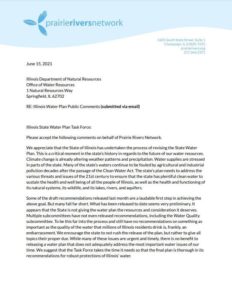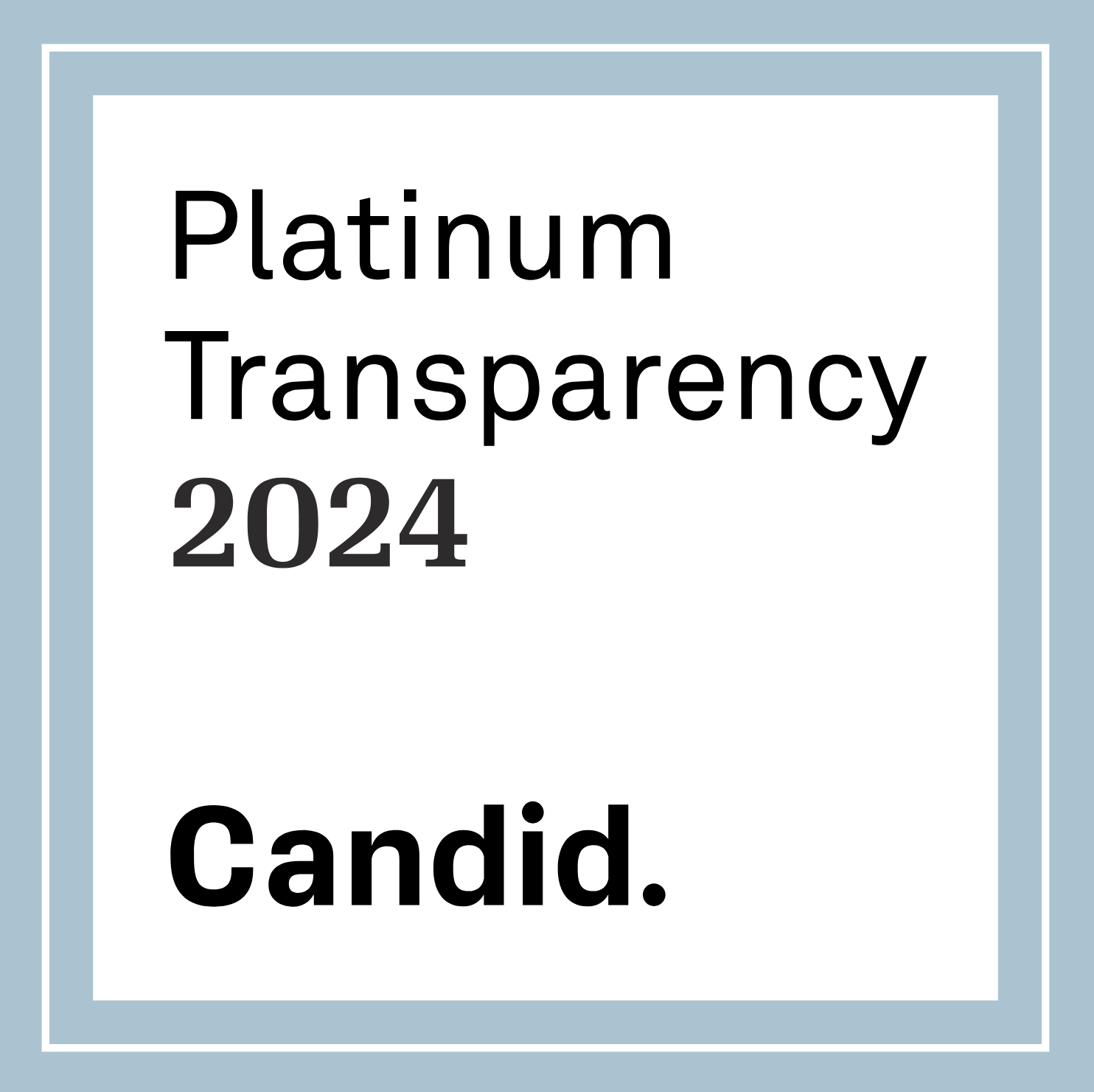We appreciate that the State of Illinois has undertaken the process of revising the State Water Plan. This is a critical moment in the state’s history in regards to the future of our water resources. Climate change is already altering weather patterns and precipitation. Water supplies are stressed in parts of the state. Many of the state’s waters continue to be fouled by agricultural and industrial pollution decades after the passage of the Clean Water Act. The state’s plan needs to address the various threats and issues of the 21st century to ensure that the state has plentiful clean water to sustain the health and well being of all the people of Illinois, as well as the health and functioning of its natural systems, its wildlife, and its lakes, rivers, and aquifers.
Some of the draft recommendations released last month are a laudable first step in achieving the above goal. But many fall far short. What has been released to date seems very preliminary. It appears that the State is not giving the water plan the resources and consideration it deserves. Multiple subcommittees have not even released recommendations, including the Water Quality subcommittee. To be this far into the process and still have no recommendations on something as important as the quality of the water that millions of Illinois residents drink is, frankly, an embarrassment. We encourage the state to not rush the release of the plan, but rather to give all topics their proper due. While many of these issues are urgent and timely, there is no benefit to releasing a water plan that does not adequately address the most important water issues of our time. We suggest that the Task Force takes the time it needs so that the final plan is thorough in its recommendations for robust protections of Illinois’ water.
Below is a list of additional recommendations that we are submitting for the consideration of the State Water Plan Task Force. These comments are organized by subcommittee topic, though many of these recommendations cut across various topic areas.
Water Quality
- This topic needs to be given the consideration it is due. The health of millions of people in Illinois depends on access to clean water. It’s shameful that the water plan process has not taken this topic seriously and that no recommendations have been submitted for public review at this time.
- The state should initiate a comprehensive review of industrial waste dumps in the state, including but not limited to coal ash outside of impoundments.
- The state should conduct a comprehensive assessment of the quality of our groundwater, including a survey of contaminants found in public and private drinking water wells. It has been 40+ years since the last comprehensive assessment and much has changed.
- We now understand more about contaminants, their persistence in the environment, and their likely sources, so an updated report would address a number of water quality issues, including:
- Contamination from human activities, such as nitrate
- Naturally occurring contaminants such as arsenic
- Changes in fertilizer and pesticide use
- Road salt in the urban areas of our state
- The increase in wells, an estimated 750,000 in use in Illinois, serving about 2 million people.
- Our aquifer maps, our understanding of groundwater and surface water interaction, our analytical capabilities, and our modeling capabilities have all improved greatly since the last assessment and would be put to good use in a new comprehensive assessment of groundwater quality.
- We now understand more about contaminants, their persistence in the environment, and their likely sources, so an updated report would address a number of water quality issues, including:
- Nitrates – Thousands of Illinoisans are at risk due to nitrate contamination of rural wells and drinking water supplies. Consumption of nitrate is associated with significant human health hazards, like Blue Baby Syndrome in infants, and more recent studies suggest it may also increase risks of various illnesses and cancers in adults. Despite serious health risks, not enough is known about the extent and degree of nitrate contamination in rural wells throughout Illinois. The limited data that does exist reveals some wells are experiencing high levels of nitrate, especially shallow wells under 100 feet deep in agricultural settings or wells along major rivers.
- The state should conduct a comprehensive survey of nitrate in rural wells.
- State well drilling records should be digitized and entered into a public database.
- The state should provide stable funding for the Nutrient Loss Reduction Strategy effort, especially the super gauges which test nitrate levels in our major rivers.
- The state should develop an outreach program for private rural well owners, educating them about nitrate and offering free nitrate testing.
- Pesticides – More than 70% of Illinois land is in row crop agriculture. The use of pesticides, some of which is entirely unregulated, has grown considerably in recent years, resulting in harmful impacts to water quality around the state.
- Restrictions should be placed on the use of pesticides, particularly insecticides, including treated seeds, near riparian areas.
- Illinois should require mandatory BMPs regarding certain agricultural practices known to cause pesticide pollution including runoff from foliar and soil applications, as well as the use of treated seeds.
- A higher tax/fee should be charged on pesticide sales and registrations and used to establish a larger fund to assist in funding BMPs and support for integrated pest management strategies.
- Many of the recommendations listed below under other subcommittees are also relevant to water quality and should be considered as such.
Climate Change
- Climate change is already impacting Illinois’ water resources. It is of course critical that the state plan for how to best manage those resources and adapt to a changing world. But it is also imperative that the state do its part to mitigate climate change by reducing greenhouse gas emissions. The water plan should set ambitious goals for the state’s energy sector. Illinois should be coal free by 2035, carbon free by 2045, and at 100% renewable energy by 2050.
Water Sustainability
- Illinois should institute a program to ensure that every community has access to clean drinking water and that streams are not unnecessarily destroyed to supply water to communities that have been forced to “go it alone” or that have decided to do so when other resources are available. See, Simmons v. U.S. Army Corps of Engineers, 129 F.3d 664 (7th Cir. 1997)
Flood Damage Mitigation
- State agencies must recognize the threat of climate change in the context of flood risk and mitigation. The behavior of rivers will become far more unpredictable with varied rainfall patterns in the Midwest, and we must take proactive measures to protect vulnerable communities in Illinois.
- When addressing flood risk throughout the state, state agencies must consider natural and green solutions. Projects that have multiple benefits on the landscape and in floodplains will address community and public safety needs as well as environmental health along important rivers.
- The state and the Department of Natural Resources must enact and strengthen enforcement against drainage districts who have altered flooding infrastructure. The hydrology of the Upper Mississippi River is significantly influenced by the use of levees, flood walls, etc. Those who operate in bad faith and have altered the footprint of levees beyond regulation should be held accountable.
- Equity and environmental justice must be a key aspect of flood damage mitigation in the state of Illinois. Years of systemic racism have placed communities of color at the frontline of many flooding and water issues. As such, special care must be taken to ensure that flood mitigation decisions are giving power and voices to those most vulnerable to the issue.
- The state should prioritize and act on a holistic watershed study for the Upper Mississippi River. It is vital to understand Illinois’ landscape and how it influences the overall health of a river beyond the floodplain, especially in the context of climate change.
Aquatic & Riparian Habitat
- Restrictions should be placed on cutting vegetation in riparian areas in all navigable waters in addition to the existing limits on such destruction on public waters.
- IEPA should not certify stream channelization projects under Section 401 of the Clean Water Act.
- Judicial review should be established for all actions permitted by IDNR that affect Endangered Species, stream flow, or riparian habitat.
- A private right of action should be created for violations of the Illinois Endangered Species Act and the Rivers Lakes and Streams Act of 1811.
- While the state has focused much of its aquatic invasive species efforts on invasive carps, the state should work in coordination with the federal government to identify and address the many invasive species currently in the Great Lakes that are at risk of entering Illinois’ rivers through the Chicago Area Waterway System.
- The state’s efforts to manage invasive carps should include a focus on rehabilitating our rivers and streams such that these water bodies support abundant native species that could serve as predators for carp.
Water Use Laws and Regulations
- Protection of Stream flow and groundwater
- IDNR should fulfill its duty to jealously guard natural conditions in Illinois Rivers Lakes and Streams under existing Illinois law. See 1987 Illinois AG decision.
- IEPA should not certify under 401 of the Clean Water Act projects that may affect the natural flow of waters or facilitate water pollution.
- Illinois should require IDNR permits to withdraw more than 100,000 gallons per day, as does Wisconsin DNR. (https://dnr.wi.gov/topic/groundwater/documents/gcc/report/wigroundwaterlaw.pdf)
- Reasonable Use Law
- New legislation should provide meaning to and enforceability of the “reasonable use” standard in Illinois’ riparian rights water law as follows:
- Link reasonableness to ecological effects and public uses. New legislation could clarify the concept of reasonable use, in both riparian rights and groundwater law, so as to protect the ecological functioning of waterways, to keep aquifer pumping to sustainable yields, and to protect public uses. In assessing a water use, the tendency of the water use to cause or worsen a violation of water quality standards, to lower the water table in an aquifer or to degrade the habitat of a threatened or endangered species, should be a factor counting against its reasonableness.
- Legal standing for public users and local governments. In the case of surface waters, a new statute could provide that all citizens who use a waterway affected by a landowner’s water use shall have standing to challenge the reasonableness of that water use. In the case of groundwater, it could state that any citizen who lives above an aquifer shall have standing to challenge the reasonableness of uses of that aquifer. This standing would include the legal ability to halt unreasonable water uses and otherwise protect the public interest. The statutory amendment could similarly empower local governments to challenge water uses that affect the welfare of their communities. It could, in particular, authorize local governments to challenge water uses that involve diversions of water outside the watershed of origin or to places away from the aquifer of origin.
- Limit physical alterations by the rule of reasonableness. Water flows and water uses are significantly affected by physical alterations and artificial drainage. A new statute could provide that, for water law purposes, physical alterations of the natural flows of waterways—whether by means of dams, detention structures or drainage practices (including urban paving)—shall be subject to the requirement of reasonableness; that is, they shall be viewed as types of water uses and shall, like all water uses, be permissible only to the extent reasonable.
- Reporting requirements. Illinois cannot plan for the best use of its water resources, nor can water users effectively protect their legal rights, without access to information about significant water uses. The new statute could include a reporting requirement for all surface- and ground-water uses above a certain level, which would be set to exclude water uses by individual households. The reporting should cover (and distinguish between) non-consumptive as well as consumptive water uses.
Navigation
- When necessary, Illinois should focus on routine maintenance and non-structural improvements to existing navigation infrastructure.
- Navigation and barge traffic on major rivers like the Mississippi and Illinois have driven decades of degradation both between riverbanks and in floodplains. In addition, demand and the amount of tonnage moving through these systems are not what it used to be. The state should advocate against and move away from large structural projects like the Navigation and Ecosystem Sustainability Program (NESP). The expansion of specific locks and dams is unnecessary and extremely costly.
- Within the Phase 2 Task Force recommendations, there appears to be a significant emphasis on maintenance through dredging on Illinois rivers in the context of “Channel Health.” This is counter-intuitive.
- Dredging is inherently damaging to river ecosystems. It results in water quality degradation and damages aquatic ecosystems. Blanket statements that express the need for more dredging on navigable waters are dangerous, and we do not support efforts to expand dredging activities where traffic does not warrant it.
- Minimizing environmental impacts is important, and we generally support the beneficial use of dredge material to that end. However, beneficial use of dredge material and the projects themselves must be analyzed by the state on a case-by-case basis.
Erosion & Sedimentation
- Nutrient loss
- Illinois should require mandatory Best Management Practices (BMPs) for certain agricultural practices known to cause nutrient pollution (see Wisconsin law: https://dnr.wi.gov/topic/nonpoint/documents/farmersneed.pdf).
- A higher tax/fee should be charged on fertilizer use to assist in funding BMPs.
- Wetlands Protection is needed, and, as is done extensively in Iowa, wetlands should be used to address nutrient runoff.
- CAFO regulations – numerous changes to the law are required to assure that CAFOs are not fueling harmful algal blooms that affect aquatic life, recreation and drinking water supplies.
Recreation
- IDNR should rely on the law granting public right of way to all navigable waters to establish water trails on waters that are valuable for recreation while advising persons of the need to avoid landing on private property while on waters that are not considered “public” waters under Illinois law. See Quad Cities Waterkeepers v. Balageer
- The law should allow IDNR to aid and fund access points to public and private waters.
- IDNR needs to provide clarity to the public regarding which rivers are legal to float and how they can be legally accessed.
- These comments also incorporate, in full, the May 24, 2021 comment letter submitted to dnr.owrplanning@illinois.gov by Eric Freyfogle (and available at www.prairierivers.org/public-rights) regarding the public’s rights to use Illinois waterways and the state’s limited authority to constrict those rights.









